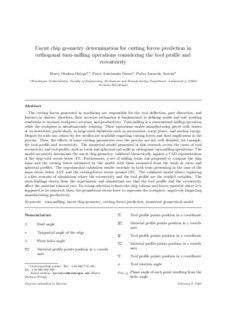Izenburua
Uncut chip geometry determination for cutting forces prediction in orthogonal turn-milling operations considering the tool profile and eccentricityArgitalpen data
2021Bertsioa
PostprintaDokumentu-mota
ArtikuluaArtikuluaHizkuntza
IngelesaEskubideak
© 2021 Elsevier Ltd.Sarbidea
Sarbide bahituaBahituraren amaiera data
2023-05-31Argitaratzailearen bertsioa
https://doi.org/10.1016/j.ijmecsci.2021.106351Non argitaratua
International Journal of Mechanical Sciences .Vol. 198. N. articulo 106351, 2021Argitaratzailea
Elsevier Ltd.Gako-hitzak
Turn-millingUncut chip geometry
Cutting forces prediction
Numerical geometrical model
Laburpena
The cutting forces generated in machining are responsible for the tool deflection, part distortion, and features as chatter; therefore, their accurate estimation is fundamental to defining stable and ... [+]
The cutting forces generated in machining are responsible for the tool deflection, part distortion, and features as chatter; therefore, their accurate estimation is fundamental to defining stable and safe working conditions to increase workpiece accuracy and productivity. Turn-milling is a conventional milling operation while the workpiece is simultaneously rotating. These operations enable manufacturing pieces with bosses or eccentricities; particularly, in large-sized industries such as aeronautics, naval power, and nuclear energy. Despite its wide use, relatively few studies are available regarding cutting forces and their implication in the process. Then, the effects of some cutting parameters over the process are not well detailed, for example, the tool profile and eccentricity. The numerical model presented in this research covers the cases of tool eccentricity and tool profile, such as torus and spherical end mills in orthogonal turn-milling operations. The model accurately determines the uncut chip geometry, validated theoretically against a CAD representation of the chip with errors below 3%. Furthermore, a set of milling trials was proposed to compare the chip mass and the cutting forces estimated by the model with those measured from the trials in torus and spherical profiles. The experimental validation results correlate in both tests presenting in the case of the mass errors below 3.5% and the cutting-forces errors around 12%. The validated model allows exploring a wider scenario of simulations where the eccentricity and the tool profile are the studied variables. The main findings drawn from the experiments and simulations are that the tool profile and the eccentricity affect the material removal rate. Its wrong selection reduces the chip volume and leaves material where it is supposed to be removed; then, the geometrical errors force to reprocess the workpiece, negatively impacting manufacturing productivity. [-]





















